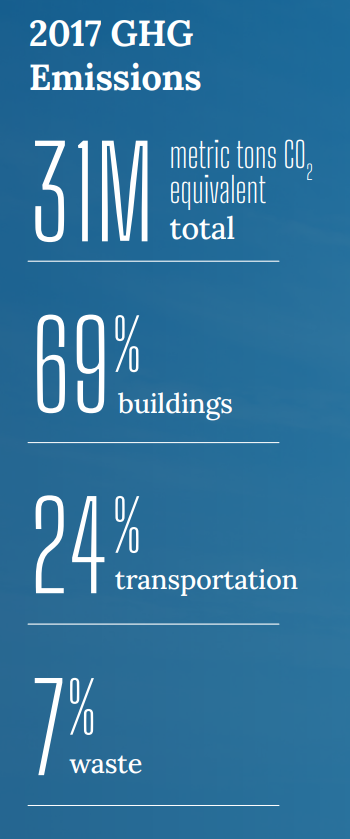Electrify Chicago
An independent tool for viewing City of Chicago building data
According to the
2022 Chicago Climate Action Plan,
69% of Chicago's emissions come from buildings, making
building emissions our biggest challenge and our biggest opportunity as a city
to tackle climate change. At Electrify Chicago, we showcase building performance using
publicly available data supplemented by community-submitted photographs and building
owners.
Start by looking at Chicago's buildings with the highest greenhouse gas intensity i.e. emissions per square foot. Large, efficient, buildings can perform much better than very inefficient small buildings on this metric.
New Article
📰 $30 Million In Missed Fines
The City Of Chicago failed to collect $30 million in potential fines from the building benchmarking ordinance, reducing transparency and accountability.
Legislative update! 🎉
As of late January 2024, legislation is being introduced to require new use more efficient forms of water and space heating, via the Clean And Affordable Buildings Ordinance (CABO), which will reduce the number of highly polluting and inefficient buildings that end up on this site.
If you're in Chicago,
write to your alderman to support the CABO!
Chicago Buildings by Greenhouse Gas Intensity
Note: Data includes large Chicago buildings with data from 2022, unless explicitly stated otherwise.
Note: This data only includes buildings whose emissions are reported
under the
Chicago Energy Benchmarking Ordinance. According to the City “As of 2016,
this list includes all commercial, institutional, and residential buildings larger than
50,000 square feet.” This dataset is also then filtered to only buildings with
reported emissions > 1,000 metric tons CO2 equivalent.
The latest year of data is from 2022, but we update the site regularly when new data is available, and some buildings may have failed to report that year, and only have older data available.
| Property Name / address | Primary Property Type |
Greenhouse Gas Intensity (kg CO2 eq./sqft) |
Total Greenhouse Emissions (metric tons CO2 eq.) |
|---|---|---|---|
|
20 E CEDAR ST
20 E CEDAR ST
| Multifamily Housing | 5.2 kg/sqft
Lowest 28%
| 887 tons
Lowest 50%
|
|
517 525 N HALSTED ST
517 525 N HALSTED ST
| Multifamily Housing | 5.2 kg/sqft
Lowest 28%
| 461 tons
Lowest 22%
|
|
399 W FULLERTON PKWY
399 W FULLERTON PKWY
| Multifamily Housing | 5.2 kg/sqft
Lowest 28%
| 675 tons
Lowest 39%
|
|
6214 6218 N WINTHROP AVE
6214 6218 N WINTHROP AVE
| Multifamily Housing | 5.2 kg/sqft
Lowest 28%
| 303 tons
Lowest 9%
|
|
Museum of Science and Industry
📷
5700 S Lake Shore Dr
| Museum | 5.2 kg/sqft
Lowest 28%
| 6,291 tons
Highest 5%
|
|
175 W Jackson
175 W Jackson
| Office | 5.2 kg/sqft
Lowest 28%
| 9,342 tons
Highest 3%
|
|
Robert Morris Center
🕰️
401 S. State St.
| Adult Education | 5.2 kg/sqft | 2,693 tons |
|
St. Rita of Cascia HS
7740 S Western Ave
| K-12 School | 5.2 kg/sqft
Lowest 28%
| 1,431 tons
Highest 33%
|
|
8747 W Bryn Mawr Ave
8747 W Bryn Mawr Ave
| Multifamily Housing | 5.1 kg/sqft
Lowest 26%
| 472 tons
Lowest 23%
|
|
343 W SCHILLER ST
343 W SCHILLER ST
| Multifamily Housing | 5.1 kg/sqft
Lowest 26%
| 496 tons
Lowest 26%
|
|
1143 S Plymouth Court
1143 S Plymouth Court
| Multifamily Housing | 5.1 kg/sqft
Lowest 26%
| 700 tons
Lowest 40%
|
|
GRAND ORLEANS CONDOMINIUM ASSOCIATION
330 W Grand Ave
| Multifamily Housing | 5.1 kg/sqft
Lowest 26%
| 1,075 tons
Highest 43%
|
|
2025 N Milwaukee Ave
2025 N Milwaukee Ave
| Multifamily Housing | 5.1 kg/sqft
Lowest 26%
| 357 tons
Lowest 13%
|
|
720 S WELLS ST
720 S WELLS ST
| Multifamily Housing | 5.1 kg/sqft
Lowest 26%
| 2,319 tons
Highest 19%
|
|
Carriage House
1545 S State St
| Multifamily Housing | 5.1 kg/sqft
Lowest 26%
| 684 tons
Lowest 39%
|
Data Source:
Chicago Energy Benchmarking Data
